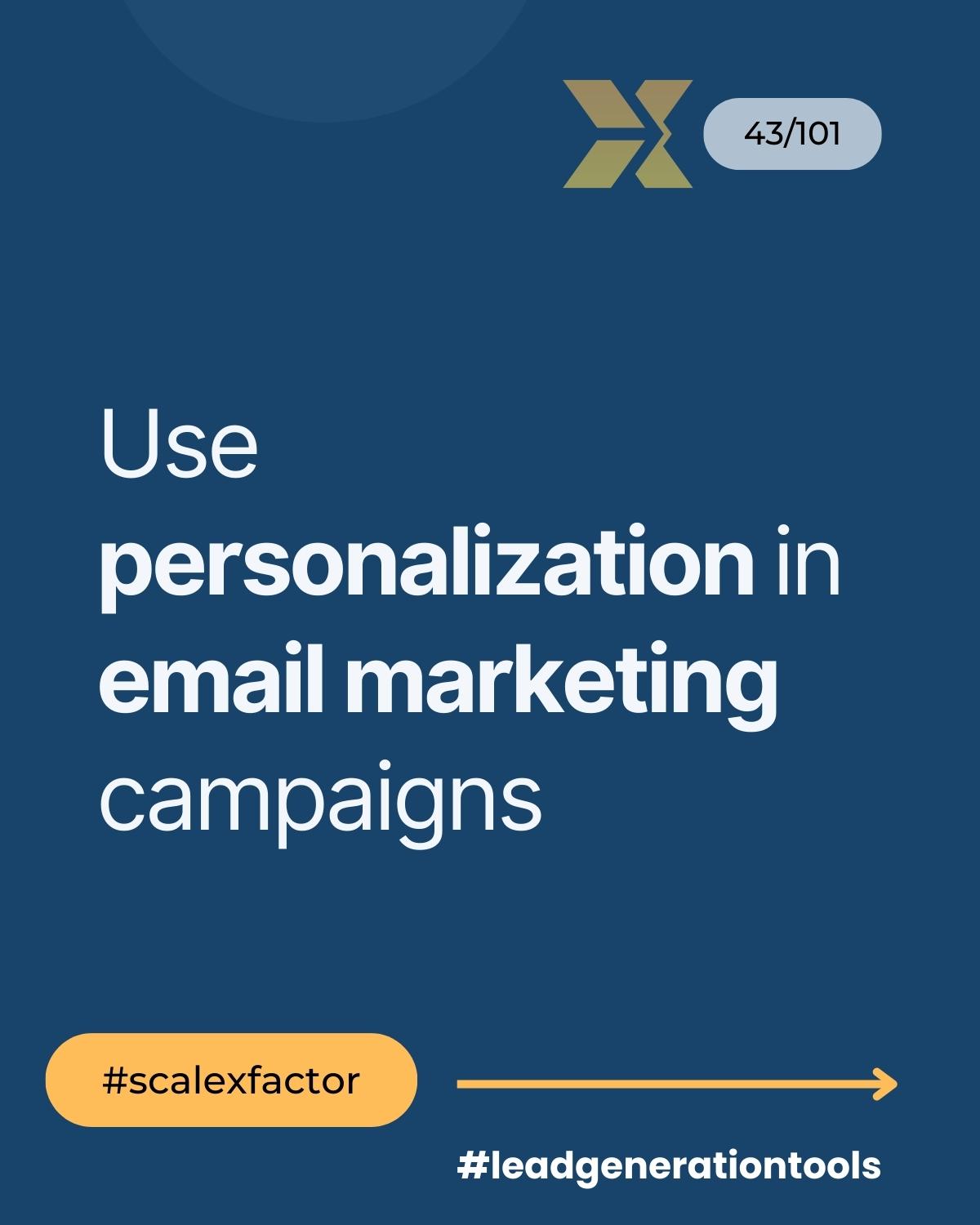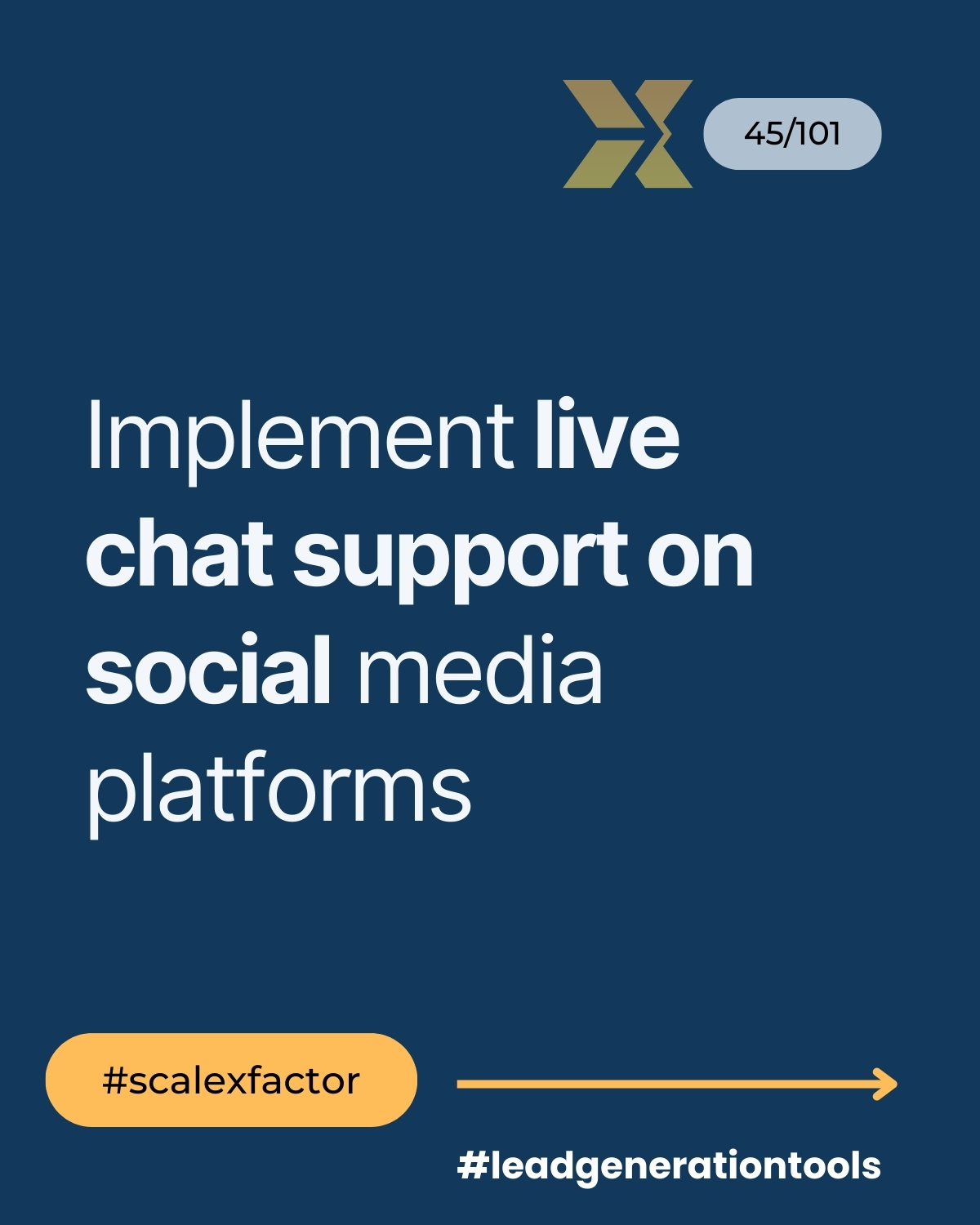Welcome to the fifteenth part of our comprehensive series, “101 Ways of Lead Generation – Tools in Modern Marketing.” Today, we embark on a journey that will revolutionize your approach to lead generation. In this installment of Lead Generation Tools, we uncover three remarkable strategies that have the power to transform your marketing efforts and propel your business to new heights.

Prepare to discover the magic of personalization in email marketing campaigns, where tailored messages forge deep connections with your audience. Unleash the potential of educational podcasts or video series to captivate and educate your target market, positioning you as a trusted authority in your industry. And explore the world of live chat support on social media platforms, where real-time interactions provide seamless customer experiences that fuel conversions.
Get ready to witness the extraordinary impact of personalization, education, and real-time support as we equip you with the knowledge and tools necessary for lead generation success. Brace yourself for a journey that will ignite your marketing prowess and unlock boundless opportunities for growth. Let’s embark on this exhilarating adventure together!

| Lead Generation Tools & Strategies | |
|---|---|
| 43rd Lead Generation Tools | Use personalization in email marketing campaigns. |
| 44th Lead Generation Tools | Create and distribute educational podcasts or video series. |
| 45th Lead Generation Tools | Implement live chat support on social media platforms. |
Personalization in Email Marketing Campaigns
Introduction: In today’s digital age, email marketing remains a powerful tool for businesses to engage with their audience. One effective strategy to enhance the impact of email marketing campaigns is personalization. Personalization involves tailoring the content of your emails to match the unique preferences, interests, and behavior of individual recipients.

Benefits of Personalization in Email Marketing Campaigns as Lead Generation Tools:
- Increased engagement: Personalized emails resonate better with recipients, leading to higher open rates, click-through rates, and conversions.
- Improved customer experience: By delivering relevant and tailored content, personalization creates a more meaningful and personalized experience for recipients, fostering customer loyalty.
- Higher conversion rates: When emails are customized based on recipient data, such as previous purchases or browsing history, it boosts the chances of driving conversions and sales.
- Enhanced segmentation: Personalization enables you to segment your audience effectively, allowing you to deliver targeted messages to specific customer segments.
- Better campaign measurement: Personalization allows you to track and analyze the performance of different personalized elements, enabling data-driven decision-making for future campaigns.
Drawbacks of Personalization in Email Marketing Campaigns as Lead Generation Tools:
- Privacy concerns: Collecting and using personal data for personalization purposes can raise privacy concerns if not handled properly.
- Data management challenges: Implementing personalization requires a robust data management system to handle the collection, storage, and analysis of customer data.
- Resource-intensive: Creating personalized content for each recipient can be time-consuming and resource-intensive.
- Risk of over-personalization: Overdoing personalization might come across as intrusive or creepy, so it’s crucial to strike the right balance.
- Accuracy and relevance: Inaccurate or irrelevant personalization can harm your brand’s reputation and alienate recipients.
FAQ: Frequently Asked Questions for Personalization in Email Marketing Campaigns as Lead Generation Tools:
Q1: How can I collect the necessary data for personalization?
A: You can collect data through customer surveys, website analytics, purchase history, and interactions with your brand across various channels.
Q2: How do I avoid privacy concerns while personalizing emails?
A: Ensure compliance with data protection regulations, obtain proper consent, and implement robust security measures to protect customer data.
Q3: How much personalization is too much?
A: It’s important to find the right balance. Start with relevant and subtle personalization based on available data and customer preferences.
Q4: Can personalization be automated?
A: Yes, with marketing automation tools, you can automate personalization based on predefined rules and customer segmentation.
Q5: How can I measure the effectiveness of personalization in my email campaigns?
A: Track key metrics such as open rates, click-through rates, conversions, and revenue generated from personalized campaigns.
Educational Podcasts or Video Series
Introduction: Educational podcasts or video series have become increasingly popular as a way to deliver valuable content to a wide audience. These mediums provide an engaging and convenient way for businesses and individuals to share educational information, insights, and expertise.

Advantages of creating and distributing educational content as Lead Generation Tool:
- Establishing thought leadership: Sharing educational content positions you as an authority in your industry and builds trust with your audience.
- Expanding reach and visibility: Podcasts and videos can reach a broader audience, allowing you to connect with new potential customers and followers.
- Building brand awareness: Educational content provides an opportunity to showcase your brand’s values, expertise, and unique offerings.
- Enhancing engagement: Educational podcasts or video series foster deeper engagement and interest from your audience, encouraging them to stay connected and follow your content regularly.
- Repurposing content: Educational content can be repurposed into blog posts, social media snippets, or downloadable resources, maximizing its impact.
Disadvantages of educational podcasts or video series as a Lead Generation Tools:
- Resource-intensive production: Creating high-quality educational content requires time, effort, and sometimes financial investment in equipment, editing software, or professional help.
- Competition and saturation: The popularity of podcasts and videos means that there is significant competition and saturation in many niches, making it harder to stand out.
- Consistency and commitment: To build an engaged audience, consistency in publishing and a long-term commitment to creating valuable content are necessary.
- Limited accessibility: Not all individuals prefer consuming educational content through audio or video formats, limiting your potential audience.
- Feedback and engagement: Generating feedback and engagement from your audience can be challenging, as the podcast or video format lacks immediate interaction.
FAQ: Frequently Asked Questions Educational Podcasts or Video Series
Q1: What equipment do I need to start a podcast or video series?
A: At a minimum, you’ll need a good microphone, headphones, and recording/editing software. For videos, a camera and proper lighting are also important.
Q2: How long should my podcast episodes or videos be?
A: Aim for a duration that keeps your audience engaged, typically between 15 to 45 minutes for podcasts and 5 to 20 minutes for videos.
Q3: How can I promote my educational podcasts or video series?
A: Utilize social media, collaborate with other influencers or experts, optimize your content for search engines, and encourage listeners/viewers to share your content.
Q4: How do I maintain consistency in publishing new episodes or videos?
A: Create a content calendar, plan ahead, and establish a consistent schedule for releasing new episodes or videos.
Q5: How can I engage with my audience and encourage feedback?
A: Encourage listeners/viewers to leave comments, questions, or reviews, and consider setting up a dedicated email address or social media accounts for audience interaction.
Live Chat Support on Social Media Platforms for Lead Generation
Introduction: In the age of social media, customers expect prompt and convenient support. Implementing live chat support on social media platforms allows businesses to offer real-time assistance, address customer queries, and provide a seamless customer experience.

Benefits of implementing live chat support:
- Instantaneous customer support: Live chat enables customers to receive immediate assistance without the need to wait for email responses or phone calls.
- Improved customer satisfaction: By offering real-time solutions, businesses can resolve issues promptly, resulting in higher customer satisfaction levels.
- Enhanced brand reputation: Responsive and efficient live chat support helps build a positive brand image and fosters customer loyalty.
- Better understanding of customer needs: Live chat conversations provide valuable insights into common customer pain points, allowing businesses to improve their products or services.
- Increased sales and conversions: Live chat support can guide potential customers through the buying process, answer their questions, and address concerns, ultimately boosting sales and conversions.
Challenges of live chat support on social media:
- Resource allocation: Implementing live chat support requires dedicated staff or resources to manage and respond to inquiries promptly.
- Managing high volumes of requests: During peak periods, handling numerous live chat conversations simultaneously can be challenging.
- Language and cultural barriers: Businesses operating in diverse markets might encounter language or cultural barriers when providing live chat support.
- Maintaining consistent quality: Ensuring consistent and accurate responses across different chat agents can be difficult, potentially affecting the customer experience.
- Availability and after-hours support: Providing live chat support around the clock might be costly or require outsourcing to cover different time zones.
FAQ: Frequently Asked Questions
Q1: Which social media platforms are best for live chat support?
A: Popular platforms like Facebook Messenger, Twitter DMs, and WhatsApp are commonly used for live chat support. Choose platforms that align with your target audience’s preferences.
Q2: How can I handle high volumes of live chat requests efficiently?
A: Utilize chatbot automation, set up pre-defined responses for common queries, and prioritize urgent or complex inquiries.
Q3: Can I integrate live chat support with my existing customer support systems?
A: Yes, many live chat tools provide integrations with customer relationship management (CRM) systems or help desk software.
Q4: How do I ensure consistent quality across different chat agents?
A: Implement training programs, create standardized response guidelines, and establish a knowledge base for agents to access accurate information.
Q5: Is it necessary to offer live chat support 24/7?
A: While offering round-the-clock support is ideal, it depends on your resources and target audience. Clearly communicate your support hours and response times to manage customer expectations.





